

Shane O'Donoghue
2025 Nissan Ariya Nismo review: Quick drive
6 Days Ago
Startup EV brand? Check. Eco credentials? Check. Head-turning inside and out? Check. Not a Tesla? Definite check. This Polestar 2 is a worthy foe...

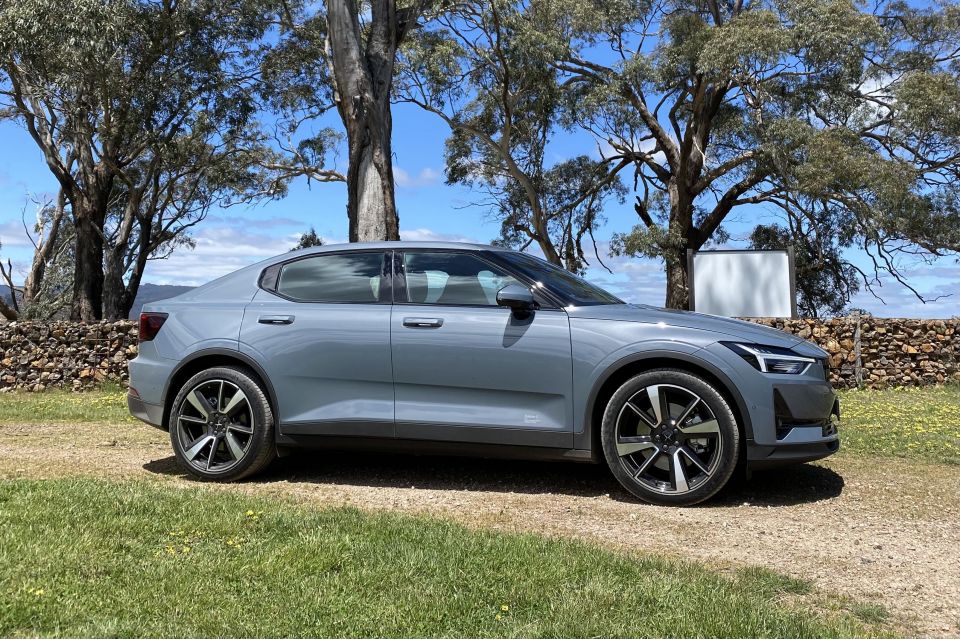

Senior Contributor

Senior Contributor


Senior Contributor

Senior Contributor
Where expert car reviews meet expert car buying – CarExpert gives you trusted advice, personalised service and real savings on your next new car.
Polestar is a Sweden-based joint venture company run by Volvo and its Chinese parent Geely Holding, poised for an imminent Nasdaq IPO.
In other words it’s very much a product of its time, a tendril of the disruptive electric car revolution – one with more products on the horizon and an approach of radical transparency around its real emissions and supply chain.
Its first volume car is the Polestar 2, a macho-modern (the chief designer calls it a “robotic statement”) liftback tasked with tackling the mass-selling Tesla Model 3 and supply-hindered Hyundai Ioniq 5.
That said, unlike this pair it sits on a Volvo platform that underpins petrol cars and EVs alike, rather than a bespoke skateboard.
Add to this a Scandi-chic, Google-powered interior and a driving character that feels like a slightly more agile Volvo, and you have an interesting recipe.
While it went on sale overseas during 2020 it’s just now hitting Australia, where it will be sold online and through brand-owned stores. Like Tesla. It’s made in China, also like the Tesla.

The entry level Polestar 2 Standard Range kicks off at a Model 3-matching $59,900 before on-road costs.
The Long Range with larger-capacity battery is $64,900, and for many will be the sweet spot. This is the variant tested here.
At the top of the range is the Long Range Dual Motor, which as the name suggests adds a second motor (at the rear) to make it all-wheel drive and 60 per cent quicker. It costs $69,900.
All prices exclude on-road costs.
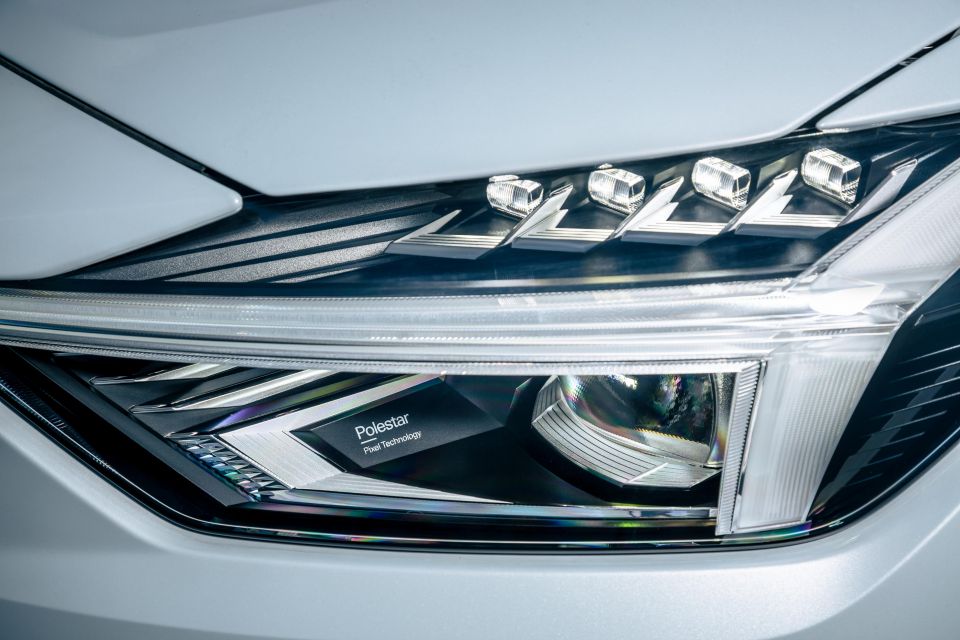


Standard specifications are the same across the board.
That means LED lights at both ends, sexy frameless door mirrors, 19-inch five-spoke wheels, a hands-free powered liftback, and walk-in keyless entry and go. Inside there are embossed textile seats that are heated for those up front, and dual-zone climate control.
On the screen front there’s an 11.15-inch centre display with portrait layout and a 12.3-inch digital instrument display. There’s an eight-speaker audio system, four USB-C inputs, Bluetooth and DAB+.
What puts the Polestar 2 into another echelon over most OEMs is having the infotainment system powered by Android Automotive OS – with Google Maps, the Google Play app store and Google Assistant (conversational “Hey Google” summoned voice control) all inbuilt.
The system has an e-SIM with constant connectivity, allowing software over-the-air updates which are already going out. A nifty range assistant was added, for example.
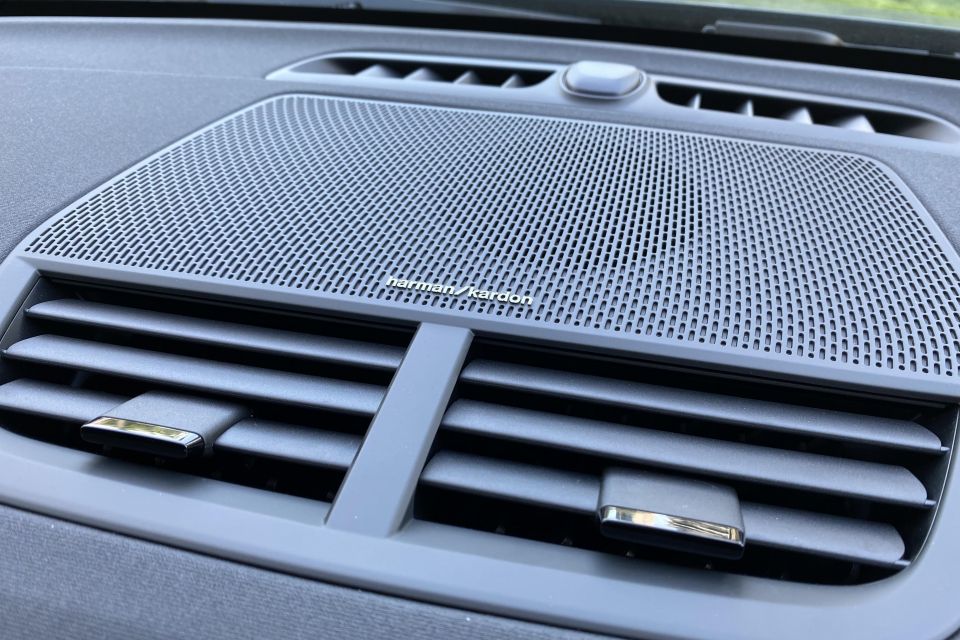
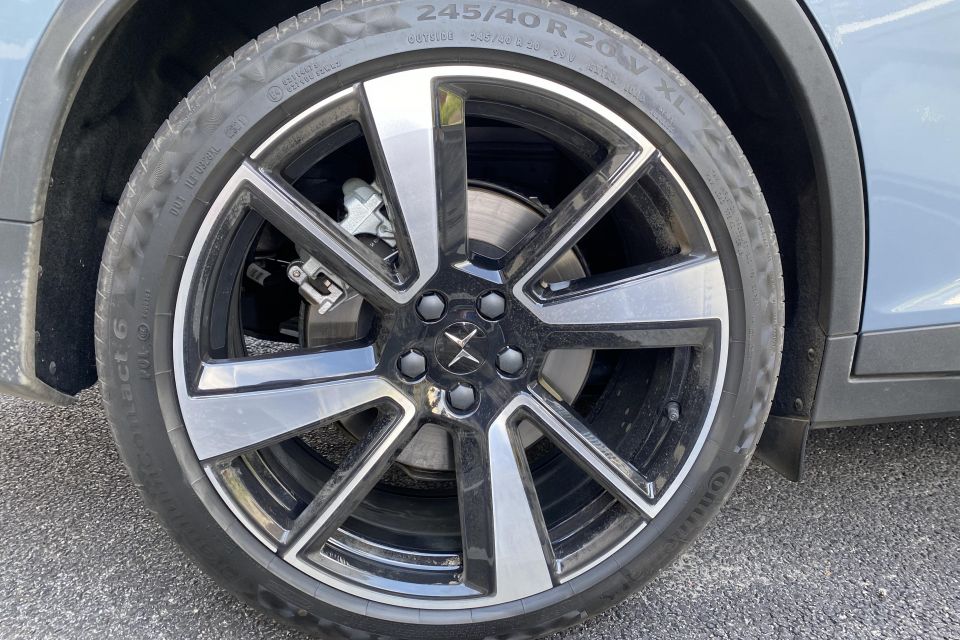

There’s a beta digital key and a phone app with vehicle monitoring and various types of functionality such as charge monitoring, climate pre-setting etc.
However, Polestar also offers two options packs in the Single Motor models: the $5000 Pilot Pack that I’ll discuss in the next section, and a $6000 Plus Pack that adds:
A Harman Kardon 13-speaker and 600W sound system, heated steering wheel and back seats, a heat pump, WeaveTech trim (billed as water and dirt resistant), more interior illumination, a panoramic glass roof, a wireless charger, and a sturdy cargo divider.
Our test vehicle had both options packages, as well as 20-inch alloys with Continental PremiumContact 6 rubber for another $1400, bringing the RRP as tested to $77,300. That’s $3900 more than a Model 3 Long Range for context, or $1400 more than a top-spec Ioniq 5.
MORE: 2022 Polestar 2 price and specs
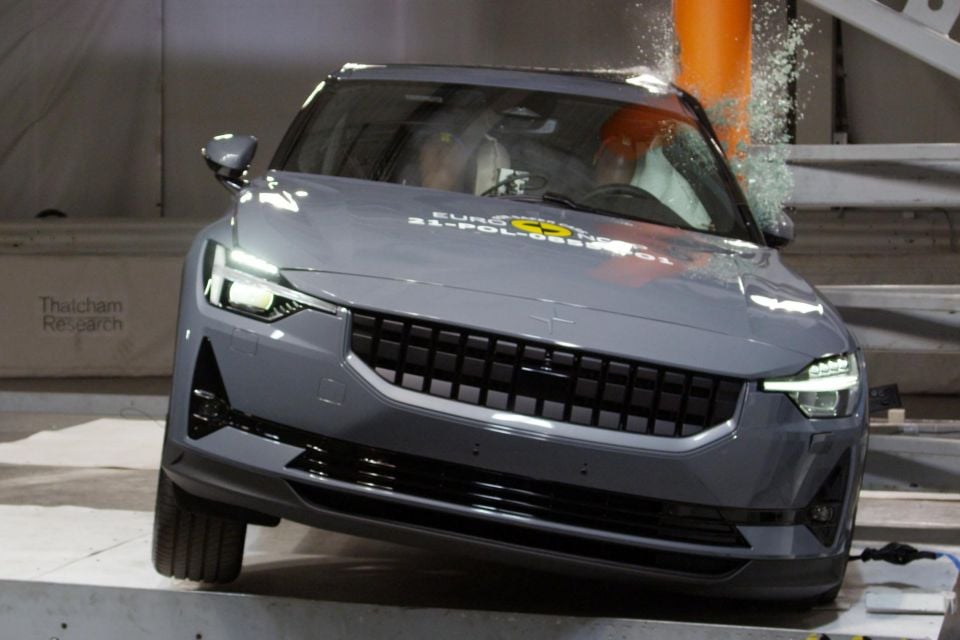

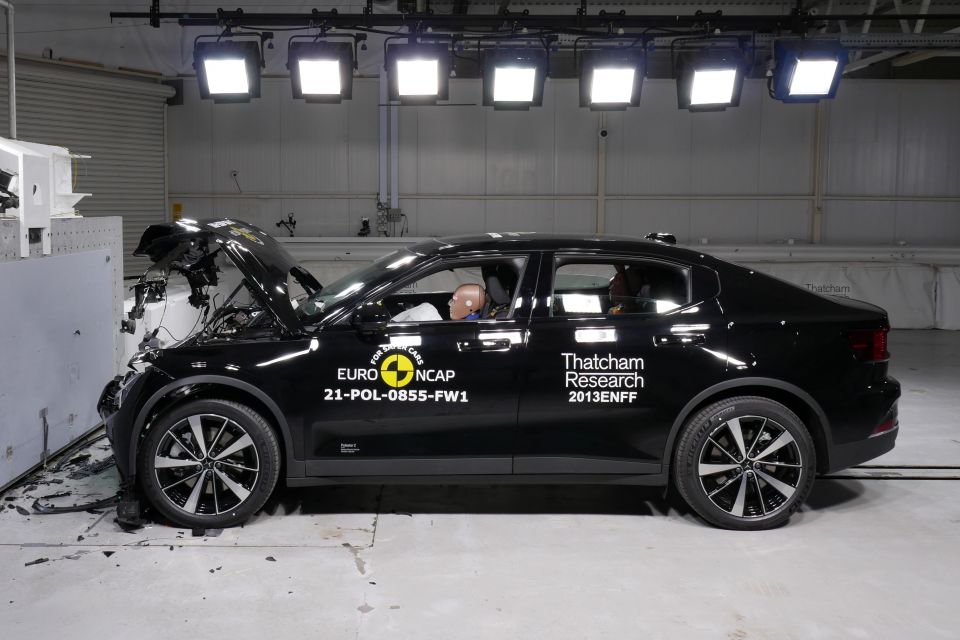
Sure is. A five-star Euro NCAP crash test including an adult occupant protection score of 93 per cent, a child occupant protection score of 89 per cent, a vulnerable road user protection score of 80 per cent, and a safety assist score of 86 per cent, attests to it.
There are dual front, front-side, inner-side and curtain airbags for impacts, and it has driver-assist features such as forward collision braking and mitigation (AEB) with steering support; run-off road mitigation; lane-keeping assist with steering; and driver attention alert.
Over the top the Pilot Pack adds blind-spot collision avoidance, cross-traffic alert with braking, adaptive cruise control, a hands-off (temporarily) Pilot Assist setting for highways that pairs the steering assist with radar cruise; a 360-degree camera, and pixel LED headlights with adaptive high beam.
I would have thought a tech-oriented, Volvo-owned smart EV brand would do well to make all the driver assist features standard. Though in fairness, Tesla charges $10,100 extra to turn on the full (FSD) AutoPilot, which offers a greater degree of functionality. Polestar’s stance also cuts the RRP.
The decision to offer this suite of tech as an option is a global one, by the way, set up to be that way across all markets.
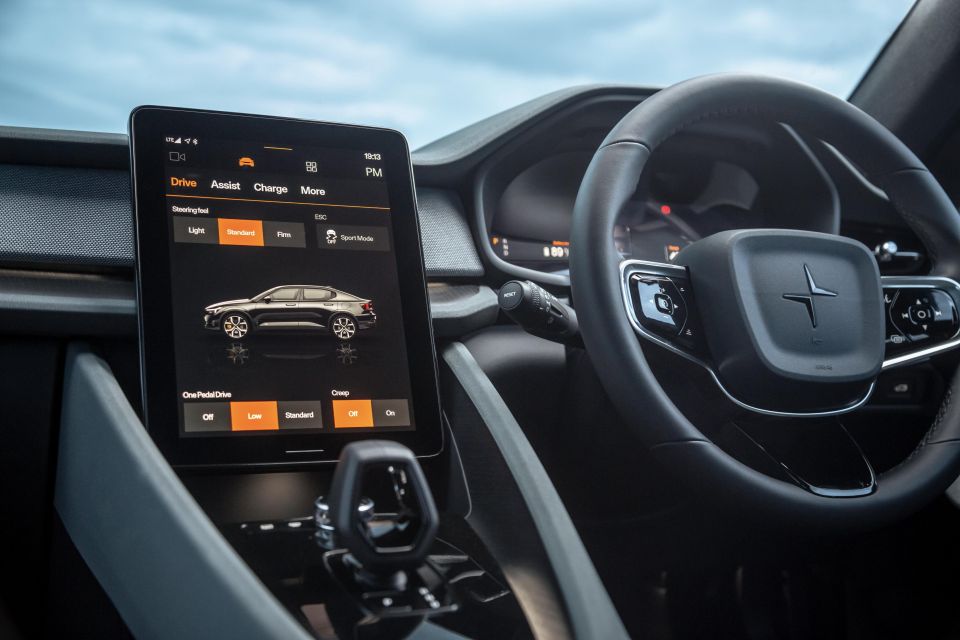
It’s a fuss-free experience getting on the move: there’s no starter button or anything, you just climb in, pull the quirky little gear shifter into D, and you’re off in silence. A seat sensor effectively replaces the start button, and the Android HMI wakes up as you approach.
The standard key fob is a Volvo unit but cheaper, shorn of its nice materials and feeling unfinished, but there’s also a small waterproof activity key tag and the Polestar Digital Key that works through the app.
There are other Volvo features, not least the facsimile steering wheel, but it’s nice and intuitive in its design so who cares about that? The left spoke adjusts cruise control and the right the audio functions and instrument display menu.

Unlike the Model 3 you get a large instrument display, and it’s beautiful.
It has a minimalist setting that only shows you core driving information, but you can also view the workings of the driver-assist features, or a full Google map overlay with epic detail and the dials smooshed to the side. A head-up display would round out the package, were it offered.
The interior is minimalist and uses interesting materials like sustainable wood, eco-friendly WeaveTech seats (you can get Nappa leather still), and really interesting fabric inserts on the doors.
The touchpoints don’t feel next-level expensive or anything, but the textures are distinctive at every turn, which to me is more fitting. Except for the over-reliance on piano black along the tunnel.
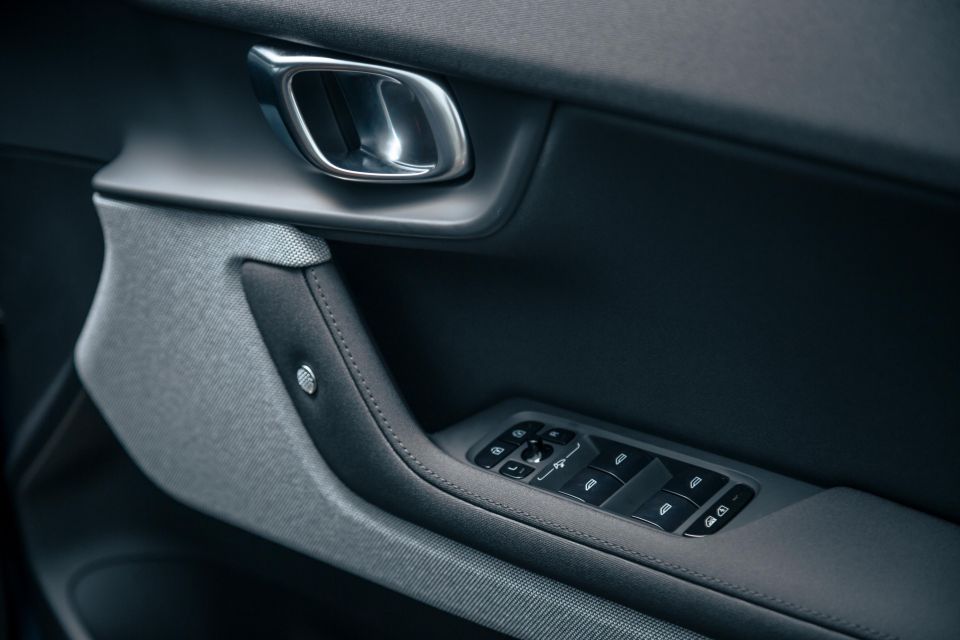


Storage is a little limited, however, especially the pokey centre console.
Because our test car came with the options packages, it also had that huge glass roof. The car still felt super stiff despite its presence, and it greatly enhances the ambience because otherwise the tones are all sombre.
My question is, despite the UV filter will its lack of a hard sliding cover become an issue in the blazing Aussie summer? This isn’t Sweden…
Let’s look at the centre touchscreen, oriented in portrait style for better maps (you can see further up the road) and reduced list scrolling. It defaults to a clean home mode with climate controls at the bottom, connectivity info up top, and four configurable tiles that run simultaneously.



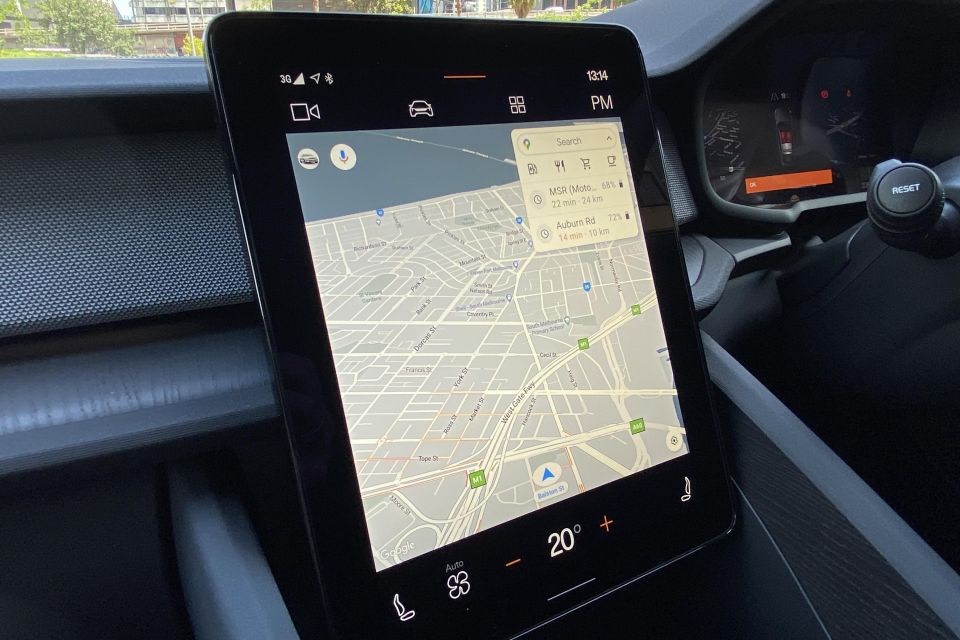
It’s as quick and responsive to pinches, zooms and taps as an Android tablet, because that’s just what it is. The Google Assistant voice control is good with accents and informal dialect, and the integrated maps mean updates and re-routing are done with snappiness.
It even tells you your expected remaining charge upon arrival at your destination in the Maps.
As much as I like Tesla’s groundbreaking system, and as good as other in-car infotainment systems are becoming, adopting the Google ecosystem makes a world of sense: people are familiar with how it works, and it’s intuitive enough to become second nature.
Polestar has rounded out the UX by reducing clutter and simplifying the menus, so for example changing the car’s driver-assist settings, charge parameters, viewing your range assistance, changing interior mood lighting and the like, are all very simple.

Signing into the Google Play store also means you can pull down apps that suit. Having a SIM and embedded Spotify, Google Maps, and myriad other services out there is the evolution from phone mirroring systems so pervasive today.
If there’s one downside it’s the 360-degree camera that’s part of the options package. It’s still helpful, but not the final word in resolution. Also, that 15W wireless charger shouldn’t be an option on an EV, should it? Yeesh, Polestar…
To the rear: the back seat legroom is okay for adults, but headroom is marginal (I’m 194cm in fairness) and the side and back windows aren’t all that large. The legacy platform means there aren’t the acres of space you might get in a ground-up EV on a skateboard.
The hatchback gives you a bigger aperture than a typical sedan, while the boot stows a modest 405 litres including the underfloor nook – unless you fold the back seats down. The cool loading partition is a great feature, reminiscent of Skoda. You can also buy 75kg-capable roof racks.



A very small 35-litre storage area.
But, putting aside the literal, the Polestar 2 driven here has a 170kW and 330Nm Valeo-Siemens electric drive motor running the front wheels, powered by a 400V and 78kWh nominal capacity liquid-cooled lithium-ion battery pack with 27 individually-repairable modules.
Polestar claims a WLTP driving range of 540km for the Long Range (up from 440km for the Standard Range with its smaller-capacity battery). The company claims energy efficiency for the mid-grade variant of between 17.1 and 18.6kWh per 100km.
Polestar claims a 0-100km/h time of 7.4 seconds. If you’ve the need for speed, the Dual Motor model has 300kW and 660Nm all up, and slashes that time to a snappier 4.7sec.
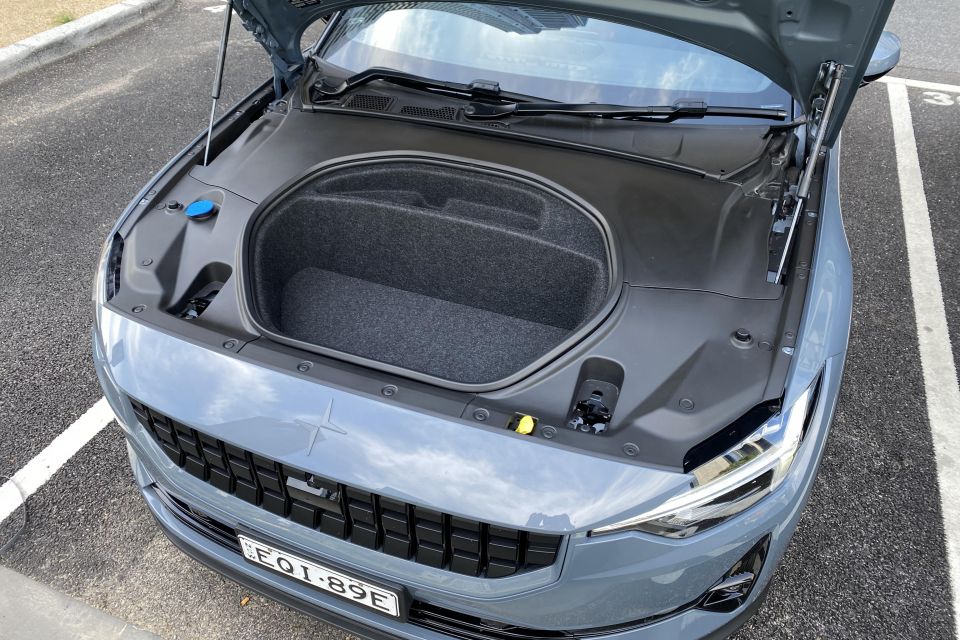
So how does this stack up? Well again, to draw comparison to the Tesla Model 3, it offers a greater 614km of range and a much brisker 4.4 second 0-100km/h time thanks to its two motors. Even the base SR Model 3 does the dash in 6.1sec.
But putting that outlier aside, the Polestar 2 does out-mile the Ioniq 5, though unlike the Hyundai it doesn’t offer 800V charging or V2L. The company has said it’s working on a V2G and V2H solution.
On the charging front, the Polestar 2 can draw up to 155kW on a CCS DC charger and in doing so is able to go from 10-80 per cent in 35 minutes. The maximum rate of 11kW means a Type 2 AC wallbox should get you from 0-100 per cent in around eight hours.
On my day-loan I swung past a Chargefox DC charger and pulled down 31.3kWh in 27 minutes.
| Polestar 2 Long Range | |
|---|---|
| Motor | Front, 170kW and 300Nm |
| Battery | 78kWh nominal |
| Energy use | 17.1-18.6kWh per 100km |
| WLTP range | 540km |
| 0-100km/h | 7.4 seconds |
| Top speed | 160km/h |
| Towing capacity | 1500kg |
| Weight | 1994kg kerb |
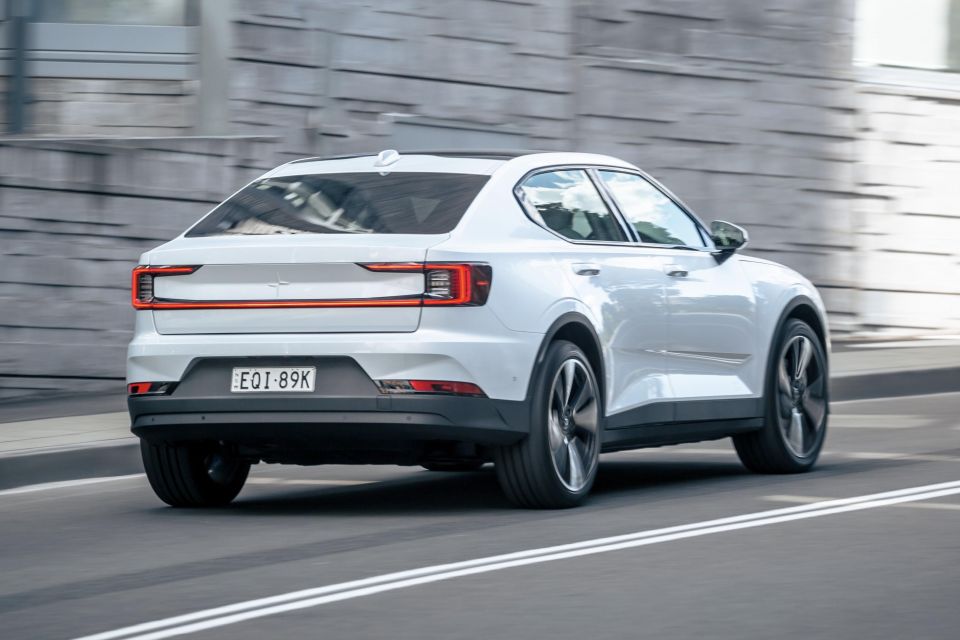
The Dual Motor gives you that punch in the chest feeling missing from the Long Range Single Motor, but the latter certainly is not slow, and nor does its torque overcome the front wheels. It’s a brisk, dignified machine rather than a proper ball tearer, which I actually admire.
The brake regen system defaults to a fairly strong degree of resistance but you can adjust this through the centre screen in two taps, ditto the anti-creeping mode. I reckon I hit the brake pedal only a handful of times on urban errands with the regen dialled up, just as I like it.
In terms of range and efficiency, my 134km highway jaunt returned 22kW per 100km energy use. After 134km covered it retained an indicated 61 per cent charge, which at that rate would mean a highway range of just under 400km.
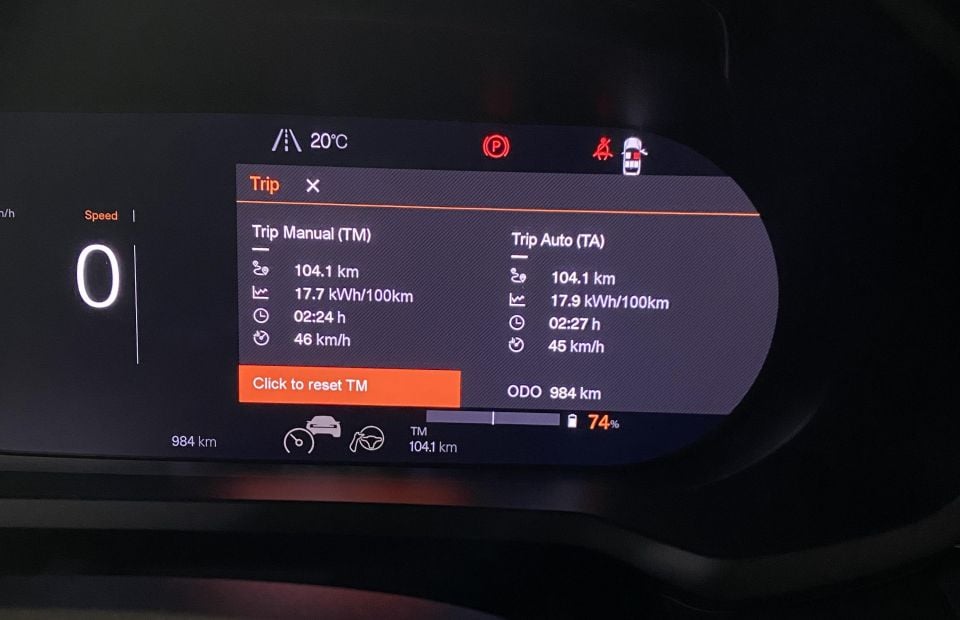
Where expert car reviews meet expert car buying – CarExpert gives you trusted advice, personalised service and real savings on your next new car.
My two-hour and 72km combined-cycle trip with an urban errand skew was better, returning use of 17.8kWh per 100km – within the WLTP range claim.
EVs are never as efficient on highways because you aren’t using the brake-energy recuperation and there aren’t gears to consider.
Dynamically, despite having a slightly elevated ride, the Polestar 2 feels like an edgier Volvo: the steering resistance can be programmed to add weight, while the monocoque’s torsional stiffness and the low battery allow quick directional changes that bely its chubby circa 2.0-tonne weight (mass is another area where it cedes a little ground to Tesla).
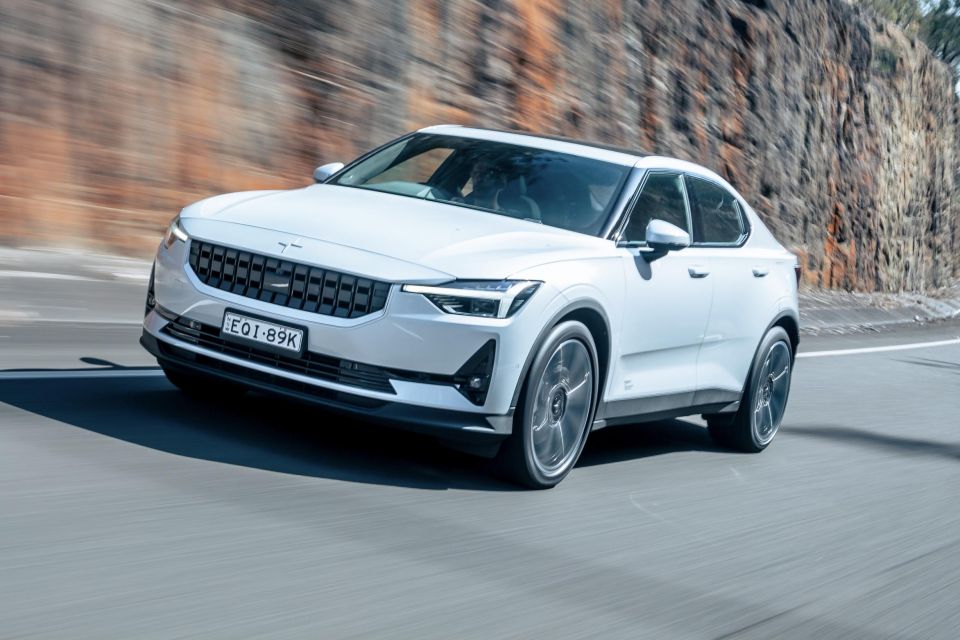
The suspension is nothing outlandish, comprising struts up front, multiple linkages and IRS at the rear, stabiliser bars at each end, and passive dampers. Despite wearing 20-inch optional wheels and slim-sidewall rubber, the Polestar’s compliance over road imperfections was actually pretty good. I was surprised.
Firm yes, brittle and harsh no.
There’s plenty of tyre roar over coarse-chip asphalt, but this is endemic to European cars with premium rubber, and especially marked when there’s no engine noise. So Polestar is not an orphan here.
The benefit of Polestar’s link to Volvo is clear when you activate the adaptive cruise control and steering assist. It’s one of the smoothest, smartest radar cruise control systems out there, and the active steering does a great job keeping you between the white lines.
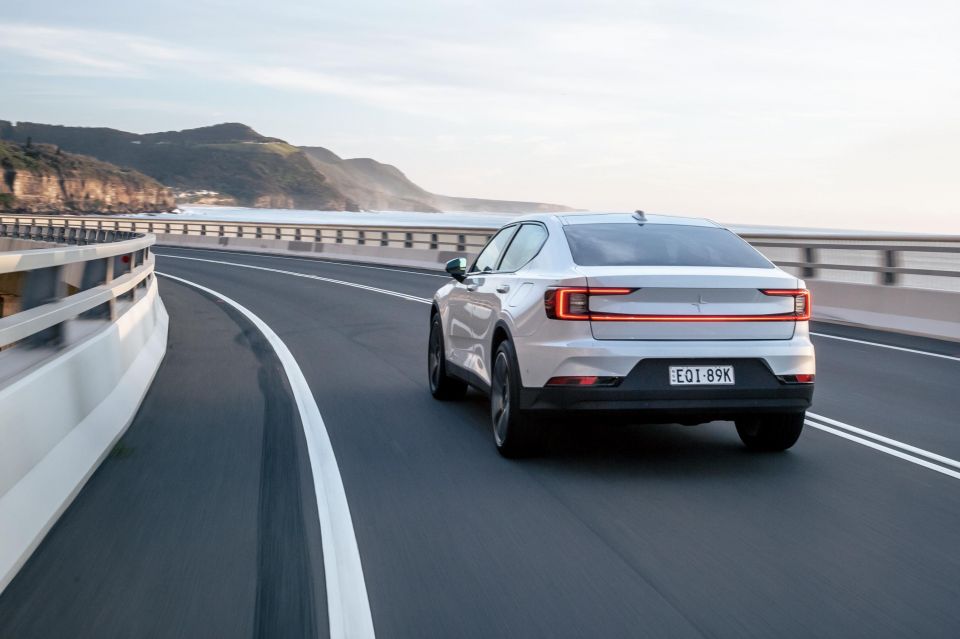
The Polestar 2 will be covered by a five-year, unlimited-kilometre warranty with an eight-year, 160,000km battery warranty.
All models also come with free servicing (you can use Volvo dealers for added convenience) and roadside assistance for five years.
If you live in New South Wales, Victoria, the ACT or South Australia, you should seek the available incentives including rebates and Stamp Duty waivers. They’re explained here.

I could delve into technical rabbit holes, but at the end of the day the Polestar 2 is just what Australia’s nascent EV market needs: namely, more proper Model 3 competitors.
It looks absolutely unique in the flesh, the interior is largely excellent with standout Google infotainment, the driving dynamics are well configured, and for a new-to-market premium brand the positioning seems acceptable – though it doesn’t reset any value benchmarks.
Like all the good EVs, regular OTA updates and app connectivity also means it should stay fresh, and we can only imagine this brand will make gains – and do so quickly.
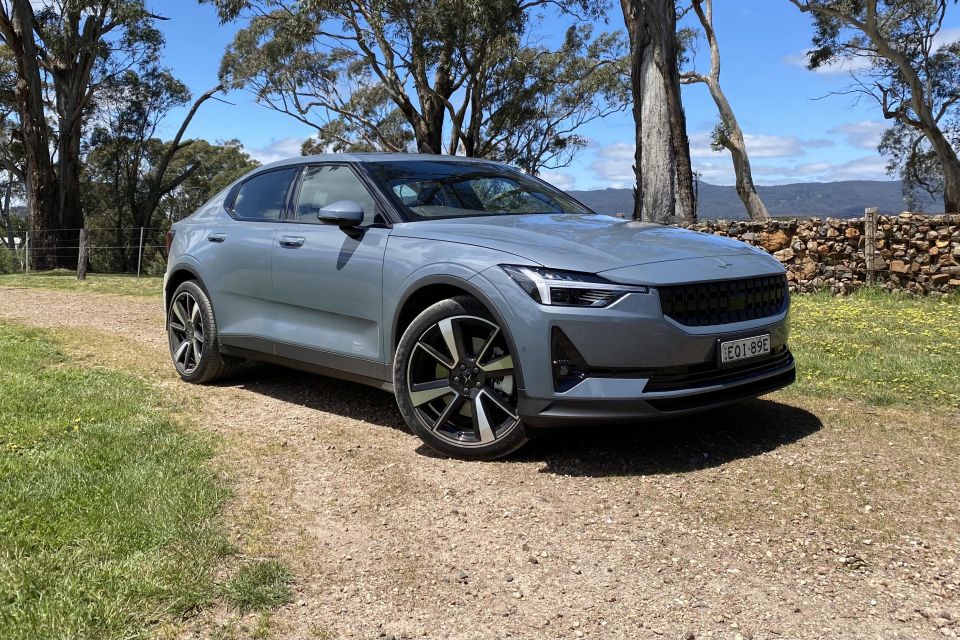
The take-away for me is, Australia is starting to get some genuine choice in the mid-tier-price EV market, which is a great thing for consumers. For a first effort the Polestar 2 strikes a good balance, an earthier and calmer Tesla perhaps.
Incidentally, while the 4.7-second sprint time of the Dual Motor might well be addictive, I think the Long Range Single Motor tested here is the sweet spot, the better balance of range, pace and price – and the one most aligned to what this brand seems to be all about.
Click the images for the full gallery
MORE: Everything Polestar 2
Where expert car reviews meet expert car buying – CarExpert gives you trusted advice, personalised service and real savings on your next new car.


Shane O'Donoghue
6 Days Ago


Anthony Crawford
5 Days Ago


Matt Campbell
4 Days Ago


James Wong
3 Days Ago


Max Davies
1 Day Ago


Josh Nevett
10 Hours Ago